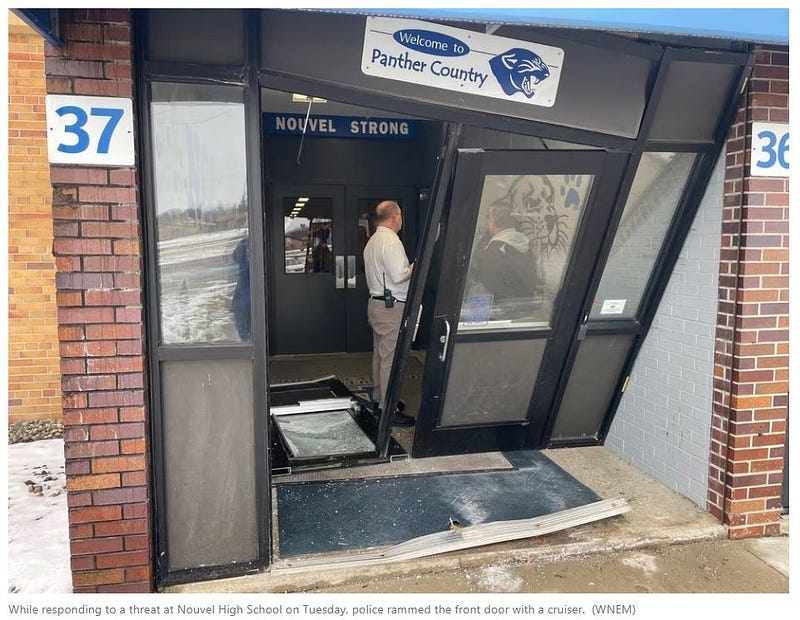One solution to swatting hoaxes is sending fewer cops
After 723 swattings at schools this year, sending dozens--sometimes hundreds--of police officers racings to these obvious hoaxes is fueling the next one.
The goal of swatting is get as many police officers as possible to respond to a hoax 911 calls. Even with dozens of hoaxes across the country each month, the pranksters keep winning as police departments fail to learn, adapt, and scale back these responses.
On November 27, dozens of officers with rifles ran into Omaha South High after a single hoax swatting call was made to the police station's front desk. This wasn’t even a caller who dialed 911, it was a call to a non-emergency number. In documenting almost 60 years of shooting at schools, I have never seen an actual shooting where the only call made was to a non-emergency number that someone would need to google (or look up in a phonebook) to find.
It’s pretty safe to say that if there really is a school shooting in progress, there won't be just one call directly to the non-emergency front desk service number.
When a student opened fired inside Oxford High in Michigan in 2021, the 911 call center received more than 100 calls within the first minute as police raced to the school, Oakland County Sheriff Michael Bouchard said. During the Nashville school shooting this year, there were dozens of calls to 911 in the first minutes of the attack.
After at least 723 swatting hoaxes at schools just this year (by my count), police departments need to be smarter about identifying a hoax and scaling back the response. Even worse, there was a school police officer working at Omaha South High. If dispatch radioed to ask him if there is a school shooting in progress and he said no, you don't need to send every federal, state, and local officer in the Omaha to the school.
Every time there is a huge police response to an obvious swatting call, police are feeding the cycle and motivating the next hoaxer.
Police responses aren’t harmless
Scaling back responses saves time, money, and reduces liability. Two departments are going to be paying out huge settlements after officers in Massachusetts and Colorado accidentally fired their guns inside occupied schools doing searches during swatting hoaxes. Officers in Michigan responding to a swatting hoax intentionally rammed their police car through the front door of the school to get inside faster (doors were locked and nobody inside the school knew about the hoax. Hint: maybe call the school and ask if there is a shooting before crashing a police car through the front door).
During my 11 month project with The Economist, determining the total cost of swatting was one of the datapoints we tried to figure out. My estimate was at least $100k for each emergency response because of SWAT call out, off-duty call in, and outside agencies responding to search the schools for hours.
This cost significantly increases if you count missed work time for all the parents who rush to the school and cost per hour of education for full day or multi-day closure. Additionally, there is damage to the school buildings when police officers break locked doors, increased risk of collisions while driving with lights and sirens, and wear/tear on police vehicle during a high speed response. Most swattings are in the morning, causing at least that full school day to be missed and often the next day too after students are traumatized by the police response.
My rough estimate of the minimum cost from swatting at schools so far in 2023 is $82,300,000. That is just the cost of the police response. The real cost that includes missed class time, missed worktime for parents, and physical damages is easily in the hundreds of millions.
Hoaxes can’t be stopped
I met with an association of telecom providers earlier this year about tracing and blocking these swatting hoaxes. With a VOIP (internet service) call that can be generated with a free account made by an anonymous email, plus a VPN creating a bogus point of origin, there is no way to trace the call without a second piece of data to triangulate back. If these were ransom or scam calls that had a bank account to transfer money, that would be the second data point. These pure hoax calls made over internet services cannot be blocked or traced.
Nobody knows why these hoaxes are happening and that is exactly what makes these swatting calls so hard to stop.
Police must change how they respond
There is an established pattern and profile from the same type of hoax in more than 30 states this year. Each emergency dispatch that elects to send dozens—or even hundreds—of officers responding to these hoaxes is perpetuating the cycle. This is a choice.
We don’t have the power to stop someone from making 911 calls over the internet. We do have the power to learn, adapt, and scale back how police respond to swatting.
David Riedman is the creator of the K-12 School Shooting Database. Listen to my recent interviews on Freakonomics Radio and the New England Journal of Medicine.






